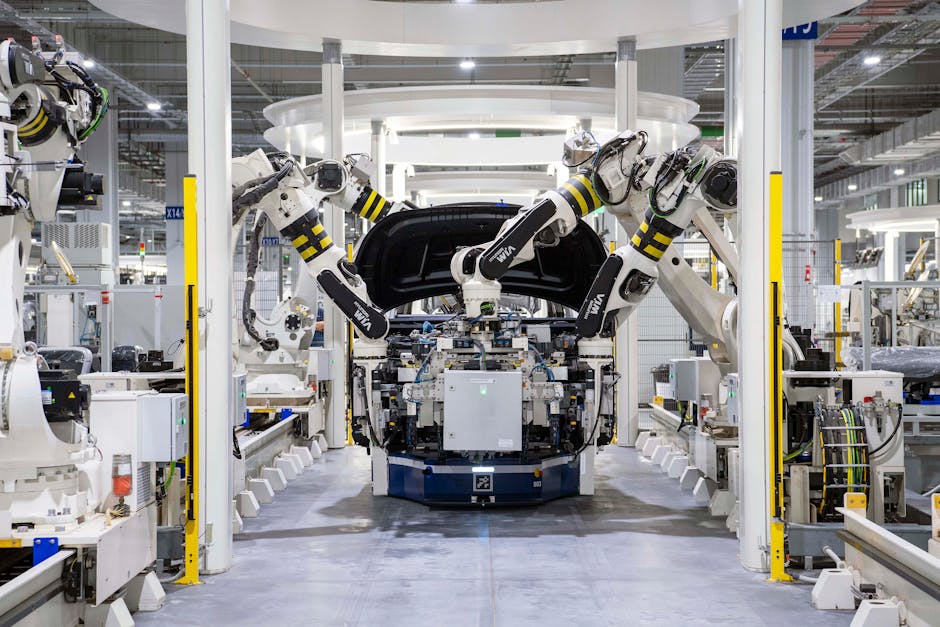Case Studies: Successful IoT Implementations
You’re looking for the Well, you’ve come to the right place! From industrial automation to smart fleet management, IoT is transforming industries left and right. Forget manual tracking and guesswork – IoT sensors and devices are optimising production, predicting maintenance, and streamlining supply chains. Route optimisation, vehicle telematics, and predictive maintenance are just a few success stories. And let’s not forget about IoT-driven energy efficiency gains! You’re about to uncover the most impactful IoT implementations that are changing the game – and we’re just getting started…
Key Takeaways
IoT in Industrial Automation

As you step into the factory of the future, you’re likely to find IoT sensors and devices working overtime to optimise production, predict maintenance, and streamline supply chains. It’s like walking into a well-oiled machine (pun intended).
The Internet of Things (IoT) has revolutionised industrial automation, and it’s not hard to see why. With Machine Learning algorithms crunching the numbers, factories can now identify areas for Process Optimisation and make data-driven decisions in real-time.
Imagine being able to predict when a machine is about to break down, and scheduling maintenance before it happens. It’s like having a crystal ball, minus the mysticism.
IoT sensors can detect even the slightest anomalies in temperature, pressure, or vibration, allowing for proactive measures to be taken. And with supply chains becoming increasingly complex, IoT devices can track inventory levels, monitor logistics, and optimise routes for maximum efficiency.
The result? Increased productivity, reduced downtime, and lower costs. It’s a triple threat of awesomeness.
Smart Fleet Management Success

Smart Fleet Management Success
About 30% of your fleet’s fuel consumption is wasted on idling, so it’s high time you started optimising routes and slashing emissions with smart fleet management. You’re not alone in this struggle – many fleet managers are still stuck in the dark ages, relying on manual route planning and guesswork to get the job done. But with the rise of IoT, you can finally ditch those dusty old maps and upgrade to a more efficient, data-driven approach.
With Route Optimisation, you can cut fuel waste, reduce emissions, and even improve customer satisfaction. But how do you make it happen? The answer lies in Vehicle Telematics – the secret sauce that turns your fleet into a lean, mean, route-optimising machine.
IoT-Driven Supply Chain Optimisation

You’re likely wasting a small fortune on inefficient supply chain management, but IoT-driven optimisation can rescue you from the dark ages of manual tracking and guesswork.
Think about it: without IoT, you’re relying on humans to manually track inventory, which is about as reliable as a teenager’s promise to clean their room. It’s a recipe for disaster (or at least, a recipe for unnecessary costs and delays).
IoT-driven supply chain optimisation, on the other hand, brings some much-needed sanity to the process. With IoT sensors and automation, you can track inventory in real-time, ensuring that you always know exactly what you have, where it is, and when it’s time to restock.
And with warehouse automation, you can streamline your operations, reducing labour costs and minimising the risk of human error.
With IoT, you can say goodby to those pesky inventory discrepancies and hello to a more efficient, more agile supply chain. It’s like having a team of super-efficient, ninja-like logistics experts working for you 24/7 (minus the coffee breaks and awkward small talk).
Predictive Maintenance in Action

By the time your equipment breaks down, it’s already too late – but what if you could catch those pesky mechanical gremlins before they wreak havoc on your operations? With predictive maintenance, you can do just that. By leveraging IoT sensors, machine learning, and remote diagnostics, you can identify potential issues before they become major problems.
Think of it like having a team of mechanical superheroes, working around the clock to keep your equipment running smoothly. And the best part? It’s not just about reacting to problems – it’s about anticipating them.
Predictive maintenance can save the day in several ways:
Reduced downtime: No more scrambling to repair or replace broken equipment. With predictive maintenance, you can schedule maintenance during downtime, minimising the impact on your operations.
Increased efficiency: By catching problems early, you can avoid costly repairs and reduce waste.
Improved safety: Predictive maintenance helps you identify potential safety hazards before they become major issues.
Better resource allocation: With predictive maintenance, you can allocate resources more effectively, reducing waste and maximising productivity.
Extended equipment lifespan: By catching issues early, you can extend the life of your equipment, saving you money in the long run.
IoT-Based Energy Efficiency Gains

One small tweak to your energy-sucking habits can have a massive impact on your bottom line – and the planet’s well-being. You know the drill: leaving lights on, computers humming, and HVAC systems cranking away 24/7. It’s like throwing cash out the window (and a few polar bears, too).
But what if you could slash those energy bills and reduce your carbon footprint without sacrificing comfort or productivity?
That’s where IoT-based energy efficiency gains come in. By leveraging smart sensors, automation, and data analytics, you can optimise energy usage in real-time. Imagine a smart building that adjusts lighting, heating, and cooling based on occupancy, time of day, and even the weather outside.
It’s like having a personal energy butler, minus the attitude (and the butler). Take energy harvesting, for instance. By integrating IoT-enabled devices, you can capture and convert ambient energy from sources like vibrations, heat, or sunlight into useable electricity.
It’s like having a mini power plant on your roof (without the noise, pollution, or fossil fuels). With IoT, you can monitor and manage energy consumption down to the last watt, making it easier to identify areas for improvement and optimise your energy strategy.
The result? Lower energy bills, reduced emissions, and a clearer conscience. You’ll be the office hero, saving the planet one kilowatt-hour at a time. So, what’re you waiting for? Get smart, go green, and start tweaking those energy habits today!
Conclusion
You’ve seen the proof – IoT isn’t just a fancy buzzword.
It’s a game-changer.
From industrial automation to energy efficiency, the cases are clear: IoT is the real deal.
So, don’t be left in the dust – jump on the bandwagon and start reaping the benefits.
Remember, when it rains, it pours – and with IoT, it’s pouring profits.
Get ready to ride the wave of innovation and leave your competition in the dust.
Contact us to discuss our services now!
